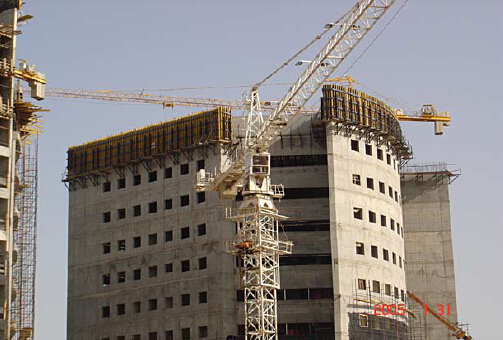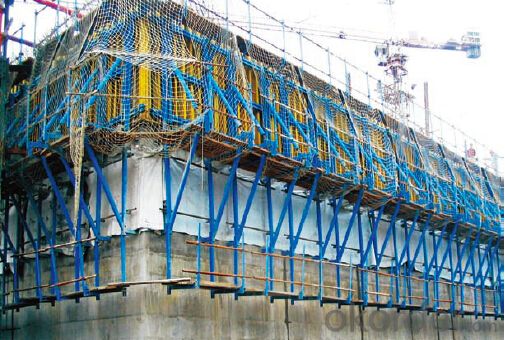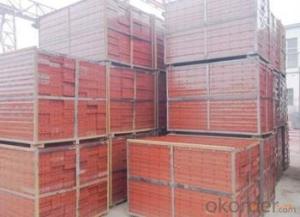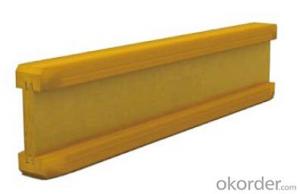Single-Side Climbing bracket for formwork and scaffolding systems
- Loading Port:
- Tianjin
- Payment Terms:
- TT OR LC
- Min Order Qty:
- 50 m²
- Supply Capability:
- 1000 m²/month
OKorder Service Pledge
OKorder Financial Service
You Might Also Like
Single-side Climbing Bracket SCB180:
With CNBM SCB 180 climbing systems, the loads from the fresh concrete pressure are
transferred through the brackets by means of V-strongbacks and compression braces into the
scaffold anchors.
Typical applications for the SCB 180 are dams, locks, cooling towers, pier heads, tunnels, and
bank vaults.
The formwork is simply tilted backwards when striking takes place. The 1.80 m wide bracket
requires only a minimum of space.
Characteristics:
◆ Economical and safe anchoring
The M30/D20 climbing cones have been designed especially for single-sided concreting using
SCB180 in dam construction, and to allow the transfer of high tensile and shear forces into the still
fresh, unreinforced concrete. Without wall-through tie-rods, finished concrete is perfect.
◆ Stable and cost-effective for high loads
generous bracket spacings allow large-area formwork units with optimal utilization of the bearing
capacity. This leads to extremely economical solutions.
◆ Simple and flexible planning
With SCB180 single-sided climbing formwork, circular structures can also be concreted without
undergoing any large planning process. Even use on inclined walls is feasible without any special
measures because additional concrete loads or lifting forces can be safely transferred into the
structure.


- Q: How does steel formwork contribute to the overall speed of construction?
- There are several ways in which steel formwork speeds up construction. Firstly, its high strength and durability allow it to handle the pressure and weight of wet concrete. This means that construction teams can pour concrete into the formwork and continue with the next steps without waiting for it to fully cure. As a result, the overall construction time is significantly reduced. Furthermore, steel formwork is highly reusable, unlike traditional timber formwork which needs frequent replacement. This means that construction crews can move from one section to another without constantly preparing new formwork. This saves both time and resources, further enhancing the speed of construction. In addition, steel formwork offers better precision and accuracy compared to other types. Its rigid structure ensures that concrete is poured and shaped exactly as intended, reducing the need for costly adjustments. This precision allows construction teams to proceed with subsequent tasks without delay. Moreover, steel formwork is lightweight and easy to handle, making it quick to assemble and dismantle. This ease of use allows construction crews to set up the formwork system swiftly, reducing installation time. Similarly, when the concrete has cured, the steel formwork can be easily disassembled and moved to the next site, further speeding up the construction process. In conclusion, the strength, durability, and reusability of steel formwork contribute to the overall speed of construction. Its precision and ease of handling also play a significant role in accelerating the process. With these advantages, construction teams can complete projects more efficiently, saving time and reducing costs.
- Q: Can steel formwork be used for water tanks or swimming pools?
- Yes, steel formwork can be used for water tanks or swimming pools. Steel formwork is a durable and strong material that can withstand the pressure exerted by water. It provides a stable and rigid structure, ensuring that the water tank or swimming pool retains its shape and does not leak. Additionally, steel formwork allows for flexibility in design as it can be easily customized to suit the desired shape and size of the water tank or swimming pool. It is also easy to assemble and disassemble, making it a convenient choice for construction projects. However, it is important to ensure proper waterproofing and coating of the steel formwork to prevent corrosion and maintain the integrity of the water tank or swimming pool.
- Q: How does steel formwork prevent concrete honeycombing?
- Steel formwork prevents concrete honeycombing by providing a sturdy and rigid structure that holds the concrete in place during pouring and curing. This prevents the formation of voids or gaps in the concrete, ensuring a solid and uniform surface without any honeycombing.
- Q: What are the different material handling requirements for steel formwork?
- Steel formwork offers numerous advantages in construction projects, such as its durability, reusability, and ability to withstand high pressure and loads. However, it is important to consider specific material handling requirements associated with steel formwork. Firstly, when handling and transporting steel formwork panels, it is crucial to use suitable lifting equipment like cranes or forklifts. This ensures that the load is evenly distributed and reduces the risk of dropping or damaging the panels during transportation. Secondly, proper storage is essential to prevent rust and corrosion. The panels should be stored in a dry and well-ventilated area. Additionally, they should be stacked evenly to avoid deformation. It is important to stack them in a way that allows easy access to individual panels without causing damage to others. Regular cleaning and maintenance are necessary to ensure the longevity and reusability of steel formwork. After each use, the formwork should be cleaned to remove any concrete residue, dirt, or debris. Additionally, it is important to inspect the formwork for any signs of damage, such as cracks or bends, and repair or replace them as needed. Skilled workers are required for the proper assembly and disassembly of steel formwork. The panels need to be accurately aligned and securely connected to form a watertight structure. During disassembly, care should be taken to avoid damaging the panels, ensuring they can be reused in the future. To enhance the durability and lifespan of steel formwork, surface protection measures should be taken. This includes applying anti-corrosion coatings or paint to prevent rust and corrosion. Regular inspections should be conducted to identify any signs of damage or deterioration on the surface, and necessary actions should be taken to maintain the integrity of the formwork. In conclusion, adhering to the material handling requirements for steel formwork, such as proper handling and transportation methods, appropriate storage and stacking, regular cleaning and maintenance, skilled assembly and disassembly, and surface protection measures, is essential for optimal performance and longevity in construction projects.
- Q: Can steel formwork be used for both manual and mechanical concrete pouring?
- Indeed, both manual and mechanical concrete pouring can utilize steel formwork. Renowned for its robustness and sturdiness, steel formwork is apt for handling the immense pressure and weight of concrete, regardless of the pouring method employed. It furnishes a steadfast and inflexible framework that endures the strains exerted during the pouring and setting of concrete. Moreover, steel formwork is adaptable and can be effortlessly modified or reconstructed to accommodate diverse configurations and dimensions of concrete structures. Consequently, it is frequently employed in construction ventures that employ both manual and mechanical concrete pouring techniques.
- Q: How does steel formwork handle concrete pumping and placing?
- Steel formwork is an incredibly strong and versatile construction material that is perfect for dealing with the pumping and placing of concrete. Its robustness and rigidity mean that it can withstand the pressure exerted by the concrete during the pumping process without any distortions or failures. This provides a stable and secure framework, ensuring that the concrete is placed and consolidated accurately. Furthermore, steel formwork offers exceptional resistance to the abrasion and corrosion caused by concrete. This is particularly crucial during the pumping and placing stages, as the concrete is often mixed with various additives and can have a high alkaline content, which can be destructive to other types of formwork materials. However, steel formwork remains unaffected by these chemical reactions, making it a dependable choice for handling concrete pumping and placing. Moreover, steel formwork is incredibly adjustable and adaptable, allowing for the creation of intricate shapes and designs. It can be easily assembled and disassembled, enabling efficient and swift reconfiguration of the formwork system to accommodate different concrete pumping and placing requirements. This flexibility makes steel formwork the preferred choice for projects that involve complex or customized concrete structures. Additionally, steel formwork provides a smooth and uniform surface finish to the concrete, guaranteeing that the final structure meets the desired aesthetic and functional requirements. The rigid nature of steel formwork helps prevent any distortions or irregularities in the concrete surface, resulting in a high-quality and visually appealing end product. In conclusion, steel formwork is the ideal option for handling concrete pumping and placing due to its strength, durability, resistance to chemical reactions, adaptability, and ability to provide a smooth finish. It offers a reliable and efficient solution for construction projects that require accurate and precise concrete placement.
- Q: Can steel formwork be used for circular columns?
- Certainly, circular columns can be constructed using steel formwork. Steel formwork possesses great versatility and can be conveniently molded into different shapes and sizes, including circular structures. Its exceptional strength and durability make it ideal for projects requiring formwork that can withstand substantial loads and frequent utilization. Moreover, steel formwork can be easily modified and utilized repeatedly, resulting in cost-effective circular column construction. Typically, the steel formwork is meticulously designed and produced to perfectly align with the precise dimensions and radius of the circular column, guaranteeing an exact and precise formwork system.
- Q: How does steel formwork contribute to the overall sustainability of the construction industry?
- Steel formwork contributes to the overall sustainability of the construction industry in several ways. Firstly, steel formwork is highly durable and long-lasting. It can be reused multiple times, reducing the need for new formwork materials for each construction project. This significantly reduces the amount of waste generated during the construction process and minimizes the overall environmental impact of the industry. Additionally, steel formwork is a more sustainable alternative to traditional formwork materials such as timber. Timber formwork often requires cutting down trees, which contributes to deforestation and habitat destruction. By utilizing steel formwork, we can reduce our reliance on timber and help preserve forests. Steel formwork also offers greater structural stability and strength compared to other materials. This allows for more efficient construction processes and reduces the need for additional support structures. As a result, less material is wasted, energy is saved, and the overall construction time is shortened, making the process more sustainable. Furthermore, steel formwork is highly resistant to weather conditions, corrosion, and fire. This ensures the longevity of the buildings, reducing the need for frequent repairs or replacements. By using steel formwork, we can create structures that have a longer lifespan, resulting in reduced resource consumption and waste generation over time. Lastly, steel formwork is recyclable. At the end of its life cycle, steel formwork can be easily melted down and reused for other applications. This reduces the demand for new steel production, conserving natural resources and reducing energy consumption. In conclusion, steel formwork contributes to the overall sustainability of the construction industry by being durable, reusable, resistant to weather conditions, and recyclable. Its use helps minimize waste generation, deforestation, energy consumption, and resource depletion, making it an environmentally-friendly choice for construction projects.
- Q: Are there any fire safety considerations when using steel formwork?
- Yes, there are fire safety considerations when using steel formwork. Steel is a non-combustible material, which means it does not burn or contribute to the spread of fire. However, during a fire, steel can lose its strength and structural integrity due to high temperatures. This can lead to structural failure, collapse, and the potential for injuries or fatalities. To mitigate these risks, it is important to implement proper fire safety measures when using steel formwork. Some considerations include: 1. Fire-resistant coatings: Applying fire-resistant coatings to the steel formwork can help protect it from heat and reduce the risk of structural failure during a fire. These coatings can provide additional fire resistance and can be rated for specific fire durations. 2. Adequate fire protection systems: Installing and maintaining fire protection systems, such as sprinklers, fire extinguishers, and fire alarms, is important to detect and extinguish fires early on. This can help prevent the fire from reaching the steel formwork and minimize the risk of structural damage. 3. Fire-resistant barriers: Installing fire-resistant barriers, such as fire-rated walls or partitions, can help contain the spread of fire and provide additional protection to the steel formwork. These barriers can limit the exposure of the formwork to high temperatures and minimize the risk of structural failure. 4. Regular inspections and maintenance: Regularly inspecting the steel formwork for any signs of damage or corrosion is crucial for identifying potential weak points that could compromise its fire resistance. Any issues should be promptly addressed, and damaged or corroded sections should be repaired or replaced. 5. Adequate fire escape routes: Ensuring that there are accessible and well-marked fire escape routes in the vicinity of the steel formwork is essential to ensure the safety of workers in the event of a fire. These escape routes should be clear of any obstructions and easily accessible to allow for quick evacuation. By implementing these fire safety considerations, the risk of structural failure and injuries related to steel formwork can be significantly reduced. It is important to comply with local building codes and regulations and consult with fire safety professionals to ensure appropriate fire protection measures are in place.
- Q: Can steel formwork be used for industrial flooring?
- Yes, steel formwork can be used for industrial flooring. Steel formwork is a durable and strong option for creating concrete slabs that are commonly used in industrial flooring applications. It provides stability, precision, and can withstand the heavy loads and frequent traffic associated with industrial environments.
Send your message to us
Single-Side Climbing bracket for formwork and scaffolding systems
- Loading Port:
- Tianjin
- Payment Terms:
- TT OR LC
- Min Order Qty:
- 50 m²
- Supply Capability:
- 1000 m²/month
OKorder Service Pledge
OKorder Financial Service
Similar products
Hot products
Hot Searches

















